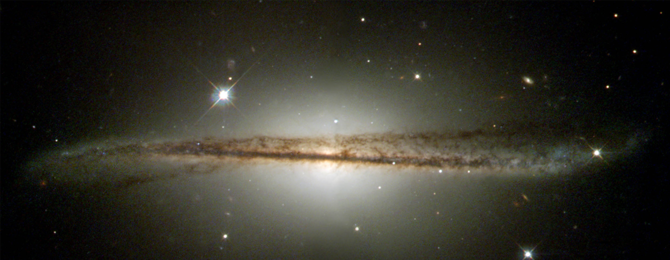Gazing at the heavens has fostered wonder, curiosity, and inspiration since ancient days. Noticing the changing movement of the sun and the stars with the passing of days, months, and seasons, stargazers and philosophers have tried to make sense of what they witnessed.
From their perspective, it was reasonable to envision the earth at the center of these movements.
We have come a long way since then!
The knowledge of our cosmic neighborhood has grown over the years to the recognition that the sun in our solar system is one of hundreds of billions of stars in the Milky Way. Furthermore, we inhabit one of the arms of this spiral galaxy, which itself is one of hundreds of billions of galaxies in the cosmos.
Recent discoveries: we live in a warped galaxy!
The Hubble Space Telescope discovered the first warped galaxy in 2001.

The news release at the time reported:
The dust and spiral arms of normal spiral galaxies, like our own Milky Way, appear flat when viewed edge-on. This Hubble Heritage image of ESO 510-G13 shows a galaxy that, by contrast, has an unusual twisted disk structure, first seen in ground-based photographs.
It turns out, however, that this “unusual” galaxy is not so unusual.
According to a National Geographic article:
Finding a warped spiral galaxy is not at all unusual; astronomers have observed numerous warped galaxies among the spirals that we can see edge-on, and the stellar conglomerate next door, a giant spiral galaxy called Andromeda, is a similarly twisted sister. But since we sit parked inside the Milky Way, it’s much more challenging to see the large-scale structure of our own galaxy.
Now, according to a study published in early August, 2019, it appears that our own Milky Way galaxy is warped. Using data from the Optical Gravitational Lensing Experiment (OGLE) and from five other surveys and catalogs, the group of researchers from Warsaw, Poland, mapped the location of over 2400 Cepheid variable stars. An analysis of their locations (most within a few 10,000 light years from the sun), revealed that the 3-D structure of the Milky Way looks somewhat like pizza dough as it is tossed in the air.
The abstract of the study describes the project this way:
They combined optical and infrared data to determine the stars' pulsation periods and mapped the distribution of Cepheids and the associated young stellar populations across the Galaxy. Their three-dimensional map demonstrates the warping of the Milky Way's disc.
Distance to the stars
Cepheid variable stars are stars whose brightness varies on a regular basis. The first variable star was observed in 1724, but it wasn’t until 1908 that a relationship between the period of variability and a star’s luminosity was established.
Observing over 1700 variable stars found in the Small and Large Magellanic Clouds, Henrietta Swan Leavitt discovered the relationship between a star’s luminosity and its period of variability. Knowing a star’s luminosity allows it to be compared to its apparent brightness, from which a star’s distance then can be calculated. Edwin Hubble used this relationship famously to calculate the distance to the nebula in the Andromeda Galaxy, our closest galactic neighbor. Ultimately, this lead to his discovery of the famous red shift, indicating that the universe is expanding.
How to find the Milky Way
These high tech space images are not the only way we can look into the heart of the Milky Way. There are signs in the night sky that we can use to get an earthly view of our galactic home.
Hidden in the ancient constellation, Sagittarrius, is an easily recognizable asterism: the “Teapot.” An asterism is a pattern of stars rather than a constellation. Best visible from July to September, its spout is a celestial signpost indicating the center of our Milky Way galaxy.
[embed]https://www.youtube.com/watch?time_continue=2&v=ygevBQWt_LE[/embed]
You can use Stellarium to find it or you can try locating it yourself by looking southeast in a dark sky. On September 1, it reaches its highest point in the sky around 8 pm, setting some three hours later; on October 1, it will reach its peak around 6 pm, again setting some 3 hours later.
The Wonders of the Milky Way: a slideshow
For your viewing pleasure, here is a short slideshow displaying the incredible beauty of the Milky Way, as seen from one of the darkest night skies on the east coast, and a few from the desert in Egypt! Photo credits go to Cameron Delafleur, a landscape photographer focused on capturing beautiful sights around the world. You can follow him on instagram at @Cameronius94.
[embed]https://youtu.be/U6eIYW95Hhk[/embed]
Cover image of the Milky Way: Symphony in Blue / NASA/JPL-Caltech
Read Also:
An Update on the Solar Parker Probe
NASA at 60: Moon Shadows and Music
Don’t Be Left in the Dust: Solar Dust and the Renewing of Our Minds

